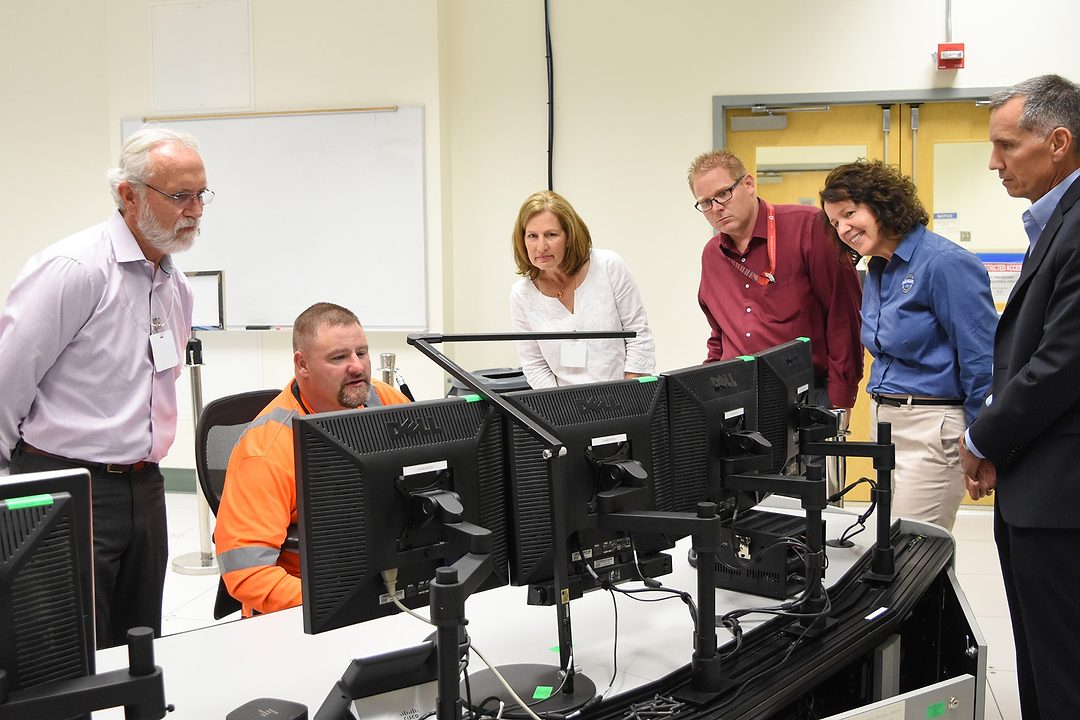
Home » Officials celebrate vit plant milestone with control room opening
Officials celebrate vit plant milestone with control room opening

September 12, 2019
By Andrew Kirk
A major milestone has been reached at the massive radioactive waste treatment plant under construction at the Hanford nuclear reservation.
Treatment of low-level waste—which makes up 90 percent of what’s in the aging tanks at the Hanford site—is scheduled to begin in 2023. That was the message during the U.S. Department of Energy’s Aug. 19 ribbon-cutting ceremony for the newly-completed Low-Activity Waste Facility annex at the Hanford Waste Treatment and Immobilization Plant, known as the vit plant, control room.
“The new control room for the Waste Treatment Plant demonstrates a key step towards our goal of treating waste here at Hanford,” said U.S. Rep. Dan Newhouse, R-Washington, at the ceremony. “The startup of low-activity waste treatment is so important for the mission of Hanford.”
Before the plant can turn nuclear waste into easy-to-store glass, it must go through a commissioning phase, which involves training staff, practicing procedures and testing systems. The parts of the vit plant ready to open soon include an analytical laboratory, the melters capable of creating five containers of glass per day, and a facility for catching and processing the effluent that escapes during melting.
The annex’s control room will oversee all three, plus about a dozen additional buildings tied to the vit plant. Vitrification of high-level waste will come later.
The opening of the annex is considered a significant step in beginning the commissioning of the plant, which means testing of the vitrification work could begin in less than two years, and the start of low-waste removal from storage tanks could begin as early as autumn 2022, said Bechtel National managers.
“This is a momentous occasion as we celebrate this completion. This job could not have been accomplished—the milestone we’ve made—could not have been accomplished without a lot of effort from a lot of people,” said Carrie Meier, local spokeswoman for the U.S. Department of Energy. “Work at the vit plant—it’s its own city—is reliant on the work of our partner contractors to continue making progress.”
Vit plant project manager Valerie McCain said significant progress has been made in the last 12 months. Moving into the annex means the necessities required to run the plant around the clock are nearly complete.
“The computerized control room is the brains of the vit plant… moving into this building is significant for this team. It means we’re moving forward. It’s a place in the project we’ve never been before. It’s really significant,” she said.
The opening of the annex is worth a ribbon-cutting ceremony because it marks the end of 18 years of construction, said Tom Fletcher, DOE project director for the plant.
“After years of talking about progress, today we’re showing it, with the opening of the annex facility,” he said. “The scaffolding is disappearing; temporary fixtures are being replaced with permanent fixtures; water, power, networks and roads are all being upgraded for 24/7 operations…. It’s a cultural change.”
Brian Vance, the Department of Energy’s site manager, said commissioning the plant is a “historic time” for the Hanford site.
Treating low-level waste is going to require Hanford-wide cooperation as it is pulled from tanks and transported to the plant, he said.
“There’s lots of reasons to be optimistic about where we are today,” he said.
Newhouse added how easy it is to take for granted the hundreds of professions that work together to make Hanford cleanup possible. It’s not just a responsibility; the investment and cooperation also has created an environment for innovation.
“Our deep history in innovation, science, technology and energy development is interwoven into the very fabric of what makes the Tri-Cities unique and so much of that begins right here at Hanford,” he said.
Since plans to create a federal depository for vitrified waste in glass blocks have stalled, the current plan is for the low-level waste encased in glass to be stored at Hanford after processing.
Fletcher said DOE staff, Bechtel staff and subcontractors all are working to find ways to finish the work as quickly as possible.
Local News
KEYWORDS september 2019





